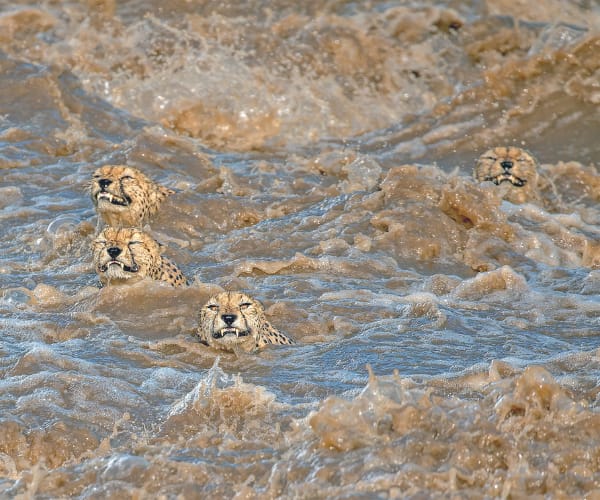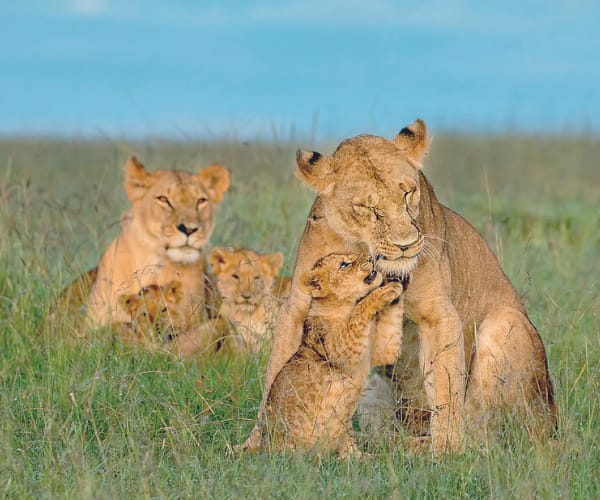Highly commended at the 57th Wildlife Photographer of the Year contest, Buddhilini De Soyza’s ‘A Great Swim’ received an explosive response for its showcasing of five cheetahs swimming across the Talek River. Buddhilini brings recognition to her passion by capturing stunning images of wildlife in which she successfully tells a story through each photo that she takes. Having travelled to many exotic places such as Africa, Buddhilini has encapsulated the lives of many animals, ranging from black-maned Kalahari lions to humpback whales.
What prompted you to become a wildlife photographer?
I’m not a professional photographer. I’m actually an investment banker by profession. However, my true passion is photography and wildlife conservation. My love affair with wildlife began when I was a toddler and was the greatest gift that my dad gave to me. I have been visiting national parks in Sri Lanka with my dad since I could walk and photography seemed a natural extension of my love of nature. I only took up photography about 10 years ago.
What has been your favourite place to capture photos of wildlife?
It’s hard to pick a favourite. My absolute favourite was most probably Botswana. The sheer exclusivity offered by the private conservancies in Botswana is second to none. We could sometimes go an entire day and not see another soul. We camped in the Okavango Delta, slept under the stars on an open deck in the Kalahari Desert and enjoyed the breathtaking aerial views from tiny bush planes! We felt our jeep vibrate with the roars of lions, spent hours with some amazing leopard families, saw cheetahs hunt, came face to face with black-maned Kalahari lions famed to be the largest lions in the world, observed the funny antics of wild dogs, were surrounded by elephants and mock charged by feisty teenagers.
Another fascinating country and my second favourite was Zimbabwe. Zimbabwe to me is Africa at its most exciting, at its most raw. We got to track wild dogs, elephants and even lions on foot with renowned wildlife conservationist and wild dog expert Nick Murray, who was heavily involved in the filming of the famous Dynasties Painted Wolf series narrated by David Attenborough.
Recently your image titled ‘A great Swim’ was highly commended at the Wildlife Photographer of the Year competition. What are your thoughts and feelings on this achievement?
This was the first time I had entered The Wildlife Photographer of the Year competition. It’s the premier wildlife award and is known as the Oscars of the wildlife photography world. My mentors, including Rukshan Jayewardene, the only other Sri Lankan photographer to get commended at this competition in 2002, encouraged me to enter this image. I was sceptical but thought that given how unique the sighting was I may have a chance to make it into the top 100. I never expected to win an award knowing how competitive the contest was and how it was dominated by professional photographers. This year the contest attracted 55,000 entries from 95 countries. I can’t quite believe that I made it into the awards.
Due to issues such as climate change and deforestation, many animals are now endangered. What is your take on this issue?
Through my images, I aim to make people understand and appreciate the beauty in nature. I hope that understanding the beauty, complexity and sheer wonder of these animals and places will inspire others to help in the conservation. Some will be encouraged to travel and experience these places. Others will want these places and animals conserved for future generations to experience and appreciate.
When talking about this particular image, in my opinion, it highlights the additional threats faced by animals due to factors such as human-induced climate change. Cheetahs already face many threats and are branded as Vulnerable. These unseasonal rains in the Mara were an added threat to these creatures who have one of the highest infant mortality rates in the world. It is said that just 5% of cheetah cubs survive to adulthood. Through this image, I hope to bring attention to the plight of these gorgeous big cats and the many conservation efforts happening around the world to ensure that they are preserved for future generations to enjoy.
What is the most satisfying part of your career?
Being able to travel to exotic places and showcase their natural wonders. To me, nothing beats the excitement of landing in a wildlife destination and being back in nature. It doesn’t matter if it is a new destination or one I have visited many times. The joy I feel when being privy to the lives of these animals is indescribable – it could be something as simple as watching the silly antics of cockatoos in my back garden in Sydney or something more exciting like watching a humpback whale breaching or a coalition of crazy cheetahs crossing crocodile-infested waters. I feel absolutely privileged that these animals are willing to share some part of their lives with us and I hope that by sharing this passion with others I can in some small way do my part in conserving these animals for future generations to enjoy.
What are some of the biggest challenges you have faced as a wildlife photographer?
Wildlife photography can be rewarding but also incredibly frustrating. You can’t get your “models” to pose for you; you have to take whatever they’re willing to give you. In wildlife photography, patience is not a virtue but a necessity. We hung around for nearly 7-8 hours in the hope that these cheetahs would cross but there was always the possibility that they wouldn’t. in fact, more often than not, our patience is not rewarded. But when it is, the results can be spectacular. And you have to be ready because you don’t get the chance to retake the shot – your are given one chance and one chance only.
I’m also always cognizant of not disturbing the wildlife in any way or doing anything that would alter their natural behaviour. This sometimes limits the opportunities you can photograph, but I would rather give up on a shot than know that my actions have resulted in an animal starving or losing a cub/hatchling.
Aside from being a wildlife photographer, what are some of your hobbies?
I love travelling (not only to wildlife destinations but also to cultural and historical locations), road tripping with my husband and two dogs, reading and hiking.
What is next for you?
Continue doing what I love. Once Australia reopens its borders, I will be on the first plane out. I’m looking forward to getting back into travelling and using my photography to bring attention to the plight of the beautiful animals I’m lucky to see and photograph.
Any words of inspiration for aspiring wildlife photographers out there?
Get out there any chance you get and keep practising. You don’t have to travel to exotic locations to get some unique photographs. I have noticed that lots of young photographers obsess about equipment. Your equipment doesn’t take the shot, you do. Yes, you do need a camera/lens of reasonable quality but it’s more important for
you to develop your skills and know your camera in and out.
And last but not least, please be a responsible and ethical photographer. There are too many out there that will do anything to get a shot. Please don’t be that photographer. Be a wildlife lover and conservationist first and a photographer second.
By Tiranya Ranasinghe




1 Comments
Kumar Punchihewa says:
Sep 15, 2021 at 07:30 pmHEARTIEST CONGRATULATIONS!